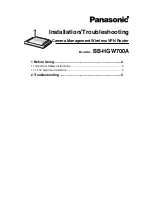
Hardware Specifications
8
About the XTM 2-Series Wireless
The WatchGuard XTM 2-Series Wireless conforms to IEEE 802.11a/b/g/n wireless LAN standards. Some key
features that have an effect on performance of an 802.11a/b/g/n wireless device include antenna directional
gain, signal attenuation (path loss), and channel data rate.
Antenna directional gain
Antenna directional gain is based on the shape of the radiation pattern around the antenna. The XTM 2-Series
Wireless uses three 2.0 dBi swivel-mount whip antennas. The whip antenna has a radiation pattern similar to
a sphere that is squashed in the center. If the antenna points up, the gain is largest in the horizontal direction
and less in the vertical direction.
Signal attenuation
Signal attenuation refers to the loss of signal power. It can be caused by multi-path reflection. Multi-path
reflection occurs when RF signals that come to the receiver must move along more than one path because of
walls and other surfaces between the transmitter and the receiver. It changes based on the phase at which the
signals come. Signal strength can be increased or decreased by as much as 30dB.
To decrease the effect of multi-path reflection, the XTM 2-Series Wireless uses two antennas spaced some
distance apart. This decreases signal cancellation and allows the software to find the best antenna to receive
and transmit as conditions change.
Wireless clients could have one or two antennas and are more sensitive to the effects of antenna location.
Because of this, the XTM 2-Series Wireless can receive signals from a wireless client even if the client does not
receive signals from the XTM 2-Series Wireless.
Channel data rate
Channel data rate changes with the modulation type, which changes based on conditions including noise and
the distance between transmitter and receiver. In general, the available data rates for an IEEE 802.11a/b/g/n
device range from 1 Mbps in the worst conditions to 300 Mbps in the best conditions.

































